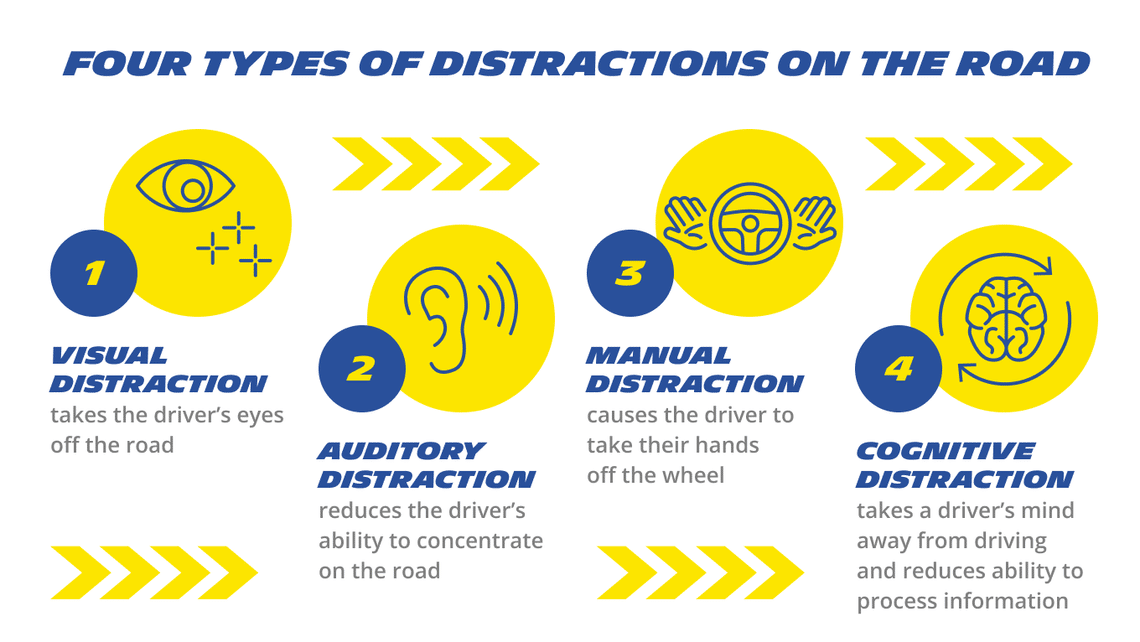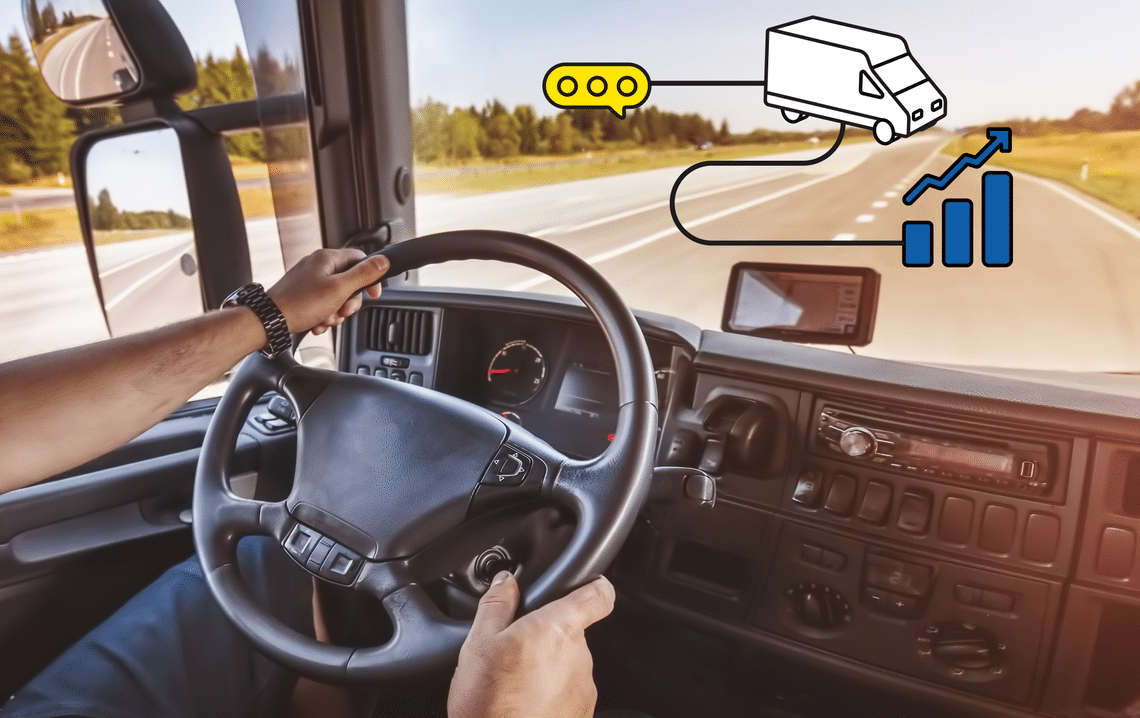
00 how to curb the risk of truck driver distraction
Young handsome indian man using smart phone in his truck
Meeting deadlines, managing fuel consumption and navigating traffic—fleet owners have a lot to juggle. However, ensuring truck driver safety must always take priority.
One of the biggest threats on the road is distracted driving, which occurs when a driver’s attention shifts away from operating their vehicle. Distractions come in many forms, from talking on the phone and eating to adjusting the radio or GPS. Even a few seconds of inattention can have serious consequences. Studies show that using a phone while driving makes accidents three times more likely1, as it impairs vision, narrows the field of view and reduces overall awareness of surroundings. This can lead to drivers taking turns too quickly, forgetting to signal or making improper lane changes.
So, how can you maintain communication with your fleet while minimising the risks of distracted driving? Let's explore the best tools and strategies to keep your drivers focused and your fleet safe.

01 distracted driving what are the main risks
The cost of a distracted truck driver
Regulatory authorities have introduced strict penalties to deter mobile phone use while driving. Professional HGV drivers caught using a smartphone behind the wheel face six penalty points and fines of up to £2,500 ౼ that’s £1,000 more than regular motorists2.
Repeat offenders, and even fleet owners, may be summoned to court, potentially facing further legal consequences, including license suspension or business penalties. These measures are designed to emphasize the serious nature of distracted driving and its impact on road safety.
Beyond legal consequences, the risk of distracted driving is severe. In 2022 alone, mobile phone use while driving led to 652 injuries in Great Britain, while overall in-vehicle distractions resulted in 4,103 injuries3. These numbers highlight the pressing need for stronger enforcement and widespread adoption of technology-driven solutions to mitigate distractions on the road. The dangers extend beyond fines and points—distracted driving increases the likelihood of severe accidents, endangering not only truck drivers but also other road users.
Services and solutions that can reduce truck driver distraction
While potential consequences are substantial, innovative services and solutions are empowering fleet managers to tackle the issue head-on.
Start by setting up a clear protocol for your team
First and foremost, setting up a clear protocol within the fleet that prioritises staying in touch while keeping drivers safe is essential. This can include encouraging drivers to set up outgoing messages on their smartphones to inform callers that they are on the road and will return calls once safely parked or forwarding calls to a designated dispatcher.
Implementing a company-wide policy that prohibits phone use while driving is also crucial. By clearly explaining the risks fleet managers can emphasise that the goal is not just compliance but improving overall safety.
Take a look below at some other tools available to help fleets curb distracted driving.
Voice command and text-to-speech solutions
For starters, fleet owners can lock down smartphone devices during drive time, only allowing essential navigation tools while the vehicle is in motion. During this time, text-to-speech systems can enable drivers to respond to messages without taking their eyes off the road, significantly reducing the risk of distracted driving. Voice-command technology further enhances safety by allowing hands-free interaction with key functions, ensuring that drivers stay focused.
Customisable GPS systems
Truck-specific GPS systems can also help keep drivers focused by eliminating the stress of navigation. These tools provide routes optimised for vehicle weight and height, while also alerting drivers to speed limits, upcoming road hazards, and other essential route changes. Some advanced navigation systems even offer real-time traffic updates, helping drivers avoid congestion and adjust their routes. This not only improves efficiency but also minimises frustration, which can be a contributing factor to distraction.
ELD (electronic logging device)
Fleet owners can streamline operations by using electronic logging devices (ELDs4) and connected truck technology. These solutions ensure that all necessary documentation is readily available before departure, eliminating the need for drivers to search for information while on the road. Additionally, automated workflow systems can help manage driver schedules and rest breaks, ensuring compliance with legal regulations while reducing the temptation to multitask behind the wheel. The integration of AI-powered fleet management tools further supports safety initiatives by monitoring driver behaviour in real time, allowing for immediate intervention when risky behaviours are detected.
Fleet management software
Fleet management software can track key parameters such as distracted driving behaviours, including harsh braking and rapid acceleration, providing valuable insights into driver habits. For example, Michelin Connected Fleet is a powerful solution that offers instant visibility into driving performance, helping fleets improve overall driving behaviour, safety, and incident management. With real-time in-cab alerts, drivers receive immediate feedback to correct unsafe behaviours on the road, while fleet managers are also notified, allowing them to follow up with targeted training opportunities to improve driving style.
Whether through instant coaching via device notifications or a driver scorecard that awards points based on performance, fleet management solutions can boost engagement, provide proactive training plans and encourage the adoption of best practices through friendly competition.

02 improve truck driver safety by reducing all unnecessary distractions
Establishing a distraction-free work environment for fleets
Reducing distracted truck driving starts with clear company policies on device usage and driving behaviour. One company making real strides in this area is the UK-based Balfour Beatty fleet division. With a priority on a “zero-harm policy”, management went to work, setting up regular eLearning modules, identifying and training high-risk drivers and even installing a cutting-edge AI-powered telematics system to monitor fatigue, distraction and mobile phone usage while driving. By prioritising truck driver safety, Balfour Beatty reduced its at-fault crash rate to 4%, compared to the industry average of 25-30%5.
Motivating drivers to stay focused
Once policies are in place, engaging drivers is crucial. Fleets can offer monetary bonuses for consistent safe driving, reward responsible drivers with company gear, or provide other prize options to boost engagement. You might also consider investing in connected solutions to enhance gamification and reward programs, promoting safer driving habits. Providing drivers with clear performance metrics fosters a culture of accountability and safety.
With the right combination of policies, driver training and technology, fleet owners can significantly reduce the risk of distracted driving. Investing in truck driver safety not only protects drivers but also enhances operational efficiency and profitability
FAQ:
Texting6 external factors and even daydreaming or fatigue are some of the biggest distractions.
Curb the use of smartphones, adopt clear company policies on device usage, plan ahead, use truck-specific GPS systems and connected truck technology.
1.INRS
https://www.inrs.fr/risques/routiers/demarche-prevention.html
2. Gov UK
https://www.gov.uk/using-mobile-phones-when-driving-the-law
4. Truck Accidents
https://truckaccidents.com/blog/steering-clear-of-distracted-driving-tips-for-truckers/
5. Fleet News
https://www.fleetnews.co.uk/features/balfour-beatty-from-zero-harm-to-zero-emissions
6. NHTSA
https://www.nhtsa.gov/risky-driving/distracted-driving

gettyimages 930571046
car going fast on a road by night






